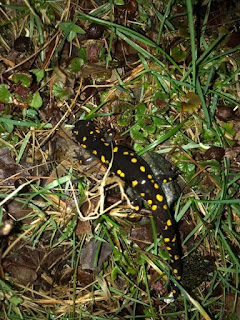Vernal pools, which are ponds that form in the woods in the spring and dry up by summer, are another great place to find amphibians.
The Vermont Center for Ecostudies has a whole page about vernal pools, including where to find them and how to report one to their vernal pool mapping project if you find one, and a page about the species of amphibians you can find around here as well. You can help conserve vernal pools and help VCE collect data about amphibians as a citizen scientist!
Check out iNaturalist, an online resource where you can share your own observations, get help identifying plants and animals you might see (you can download an app where you can take a photo of a plant or animal you see that you want to know the name of, and iNaturalist will make some suggestions about what it is), and find out how to help scientists.
Have you heard about Big Night?
It's the first warm, rainy night in spring when amphibians begin their massive migration to their breeding ponds and pools. Sometimes people set up "salamander crossings" and go out to help these amphibians make it across road ways. Here is an interesting news story from NHPR all about Big Night!During Covid19, my kids and I have been doing a lot of exploring in our woods and pond, and many of their classmates have been doing the same. Online school has its challenges, but one thing I am really appreciating is the extra time we have to spend outside exploring! We have seen so much more of the natural gifts spring has to offer than we usually do.
Below are some examples of the MANY amphibians students have found on their outdoor adventures!
 |
| A Red Eft found by a classmate. Red Efts are actually the juvenile stage of the eastern newt. Red efts are land dwelling, but the adult stage of the eastern newt is aquatic. |
 |
| Spotted salamander found by a teacher (we are getting outside more too!). The spotted salamander is common in eastern north America, and is frequently found in vernal pools in spring. |

No comments:
Post a Comment